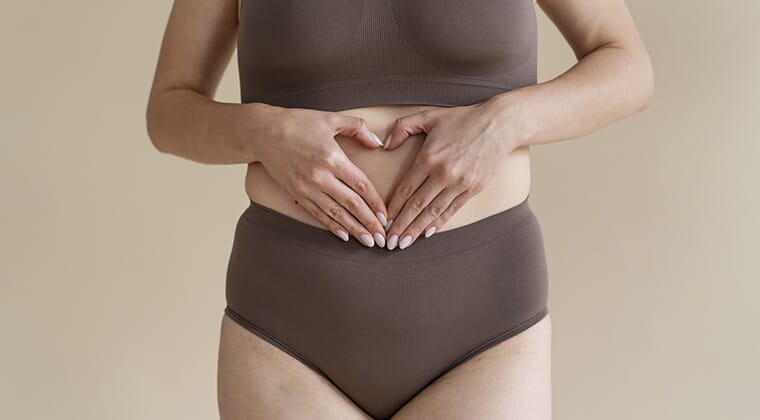The connection between the chemical BPA and fertility is something that always comes up in our community. It’s a hot topic for parents to be and parents alike, as there are potential risks for both fertility and babies. In today’s blog, we’ll walk you through the potential dangers of BPA and explain ways you can avoid it.
What is BPA?
Bisphenol A, also known as BPA, is a chemical that has been used to make plastics since the Sixties. It can be found in many household items, including water bottles and food containers. However, it’s also used to make a material called epoxy resin, which lines the inside of metal cans and tins. It also pops up in less obvious places – like sanitary products hence why many women are turning to plastic-free, sustainable options for their periods.
Back in the day, there would be way more BPA in your house than there is now. It was commonly used everywhere, but since concerns about its safety have been raised, there are certain products that are no longer made with BPA. In 2010 both the American FDA and the European Commission asked manufacturers of items used by babies – like bottles and sippy cups – to stop using the chemical. Many manufacturers now choose to offer a BPA free alternative
Can BPA get into my body?
The short answer is yes. Across numerous studies, BPA was found in the urine of subjects. In the UK, Canada and America, urine was found in over 90% of test participants – proving that our exposure to BPA is pretty far spread. The main source of BPA exposure is through our diet – and the containers our food and drink come in. During the manufacture of containers and bottles, not all of the BPA is sealed. This allows it to break free and mix with the contents that we consume. It seems like this is particularly prevalent when heat gets involved – for example when microwaveable containers are heated.
A 2011 study showed that the BPA levels in urine decreased by 66% when participants avoided packaged foods. This is not only a concern for ourselves but our children. The WHO reported that BPA levels of breastfed babies were considerably lower than formula-fed babies who were fed from bottles containing BPA.
Is BPA actually harmful?
There is a lot of controversy over the safety of BPA – and studies have been conflicting. Research from within the industry showed no signs of danger for humans from low levels of BPA. However, 98% of studies undertaken from outside of the industry have shown at least some detrimental effects to our health. So, make of that what you will…
The theory goes that BPA mimics the structure of the hormone oestrogen. This means it can bind to oestrogen receptors and impact the job of the hormone as well as other hormones in our body. As our delicate hormonal balance is integral to almost everything that goes on in our bodies, it makes sense that the chemical could wreak havoc with our health.
Most of the health concerns surround the welfare of babies and children, as they would naturally be more vulnerable to hormonal imbalances caused by low levels of BPA. Various studies have indicated a link between BPA exposure and brain development, obesity and ADHD. There is even reason to believe that it could increase the risk of heart disease and cancer. Whilst there is still much research needed, and the majority of these tests have only been conducted on animals, it’s still concerning.
What’s the connection between BPA and fertility?
This is still an area of great scientific scrutiny. However, there have been numerous studies over the last decade which have indicated that BPA can have a negative impact on both male and female fertility.
BPA and female Fertility
As BPA can impact the effectiveness of estrogen – one of the key sex hormones – it makes sense that people would be concerned that it could affect female fertility.
One study observed that women who suffered from recurrent miscarriages had about three times more BPA in their system than women who had carried babies to full term. Another study indicated a link between BPA and egg development. Researchers found that exposure to the chemical caused a variety of problems with the maturation process of eggs. Not only did it seem to cause a reduction of the number of eggs that matured, but those that did often displayed abnormalities. This could potentially explain the increased risk of miscarriage. Some scientists also believe there could be a link between BPA exposure and conditions including PCOS and endometriosis.
BPA and male fertility
There also seems to be a risk associated with BPA and fertility in men. Research has indicated that men with high BPA levels are 3-4 times more likely to have poor quality sperm. The study seemed to show that both sperm concentration and count were lowered the more BPA the subject had in their system. A separate study reported that during the IVF process, men with the highest BLA levels were 30-46% more likely to produce lower-quality embryos.
There is still so much research needed to be done – and the above facts are by no means completely conclusive. But with so many independent studies reporting similar results – it’s hard to believe that there isn’t some sort of connection between BPA and fertility.
However, it’s important to remember that BPA alone is unlikely to cause infertility. You should certainly not feel guilty if you are experiencing fertility struggles for any reason – including using plastic. Leading a healthy lifestyle — eating a balanced diet, getting plenty of exercise, and quitting smoking — are things that you should focus on during the preconception phase or if you are on a fertility journey. If you start eating more fresh foods you are also likely to reduce your BPA exposure without even thinking about it!
But, BPA free products should be fine, right?
Not exactly. With the conversation regarding BPA and health heating up over the last decade, there have been changes. Many brands and manufacturers have started making BPA free versions of their products, to satisfy growing consumer demand. However, many BPA-free products have merely replaced BPA with bisphenol-S (BPS) or bisphenol-F (BPF). Think they sound pretty similar? It’s because they are. These alternatives share a similar chemical structure and potentially react similarly in our bodies.
An American study found that even small concentrations of BPS and BPF disrupted the cell function of animals in a worryingly similar way to BPA. This could mean that all those BPA-free products we bought to protect us, could actually end up being just as harmful down the line.
How can I avoid BPA all together?
As BPA is used in so many ways, it might be difficult to avoid it altogether. It can be especially difficult in situations out of our control – for example in restaurants. But there are lots of ways that you can reduce your BPA consumption – and the risk associated with it – dramatically. Here are a few of our BPA-limiting tips…
Look out for recycling numbers
Plastic items labelled with the recycling numbers 3 and 7 or letter ‘PC’ likely contain BPA, BPS or BPF. This can be useful if you are in the supermarket and trying to looking for the safest option.
Make the plastic-free switch
Stainless steel or glass water bottles aren’t just a fashion statement. They are a plastic (and BPA) free alternative that’s better for you and the planet. You should also try removing plastic from your fridge, instead of storing food in glass c or ceramic containers.
Avoid heat
If you do have plastic in your kitchen, keep it away from heat. Avoid microwaving meals in plastic containers as this is when BPA is often released into our food,. You should also hand wash them rather than popping them in the dishwasher.
Think about your coffee
Whilst George Clooney does a great job of making coffee pods extremely desirable, they could actually be a key source of BPA exposure. The boiling water heats the plastic pods as it is passed through, so you’re better switching to a cafetiere.
Say No to Deliveroo
Takeaways can be tempting when leading a busy lifestyle. However, the vast majority comes in tonnes of plastic containers that are full of BPA. Eating freshly cooked meals at home will allow you to have control over how these meals are cooked and contained. They’re also healthier too.





